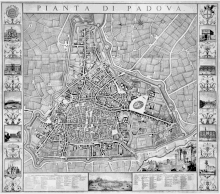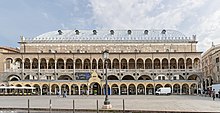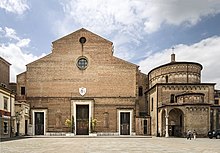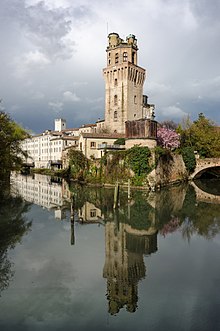Padua
| Padua | ||
|---|---|---|

|
|
|
| Country | Italy | |
| region | Veneto | |
| province | Padua (PD) | |
| Local name | Pàdo (v) a | |
| Coordinates | 45 ° 24 ' N , 11 ° 52' E | |
| height | 12 m slm | |
| surface | 92 km² | |
| Residents | 212,395 (Dec. 31, 2019) | |
| Population density | 2,309 inhabitants / km² | |
| Post Code | 35100 | |
| prefix | +39 (0) 49 | |
| ISTAT number | 028060 | |
| Popular name | Padovani or Patavini | |
| Patron saint | Anthony of Padua | |
| Website | Padua | |

|
||
Padua ( Italian Padova , Latin Patavium ) is an Italian municipality and capital of the province of Padua of the same name . It is located on the edge of the Po Valley , 30 km west of Venice , on the Bacchiglione river and has 212,395 inhabitants (as of December 31, 2019).
history
Antiquity
Padua is one of the oldest cities in Italy. According to legend, it was discovered by the Trojan Antenor around 1184 BC. Founded. It is documented that in the 4th century BC A fishing village was established on the Bacchiglione river. The region quickly developed into an important center for the Venetians . 302 BC The Paduan militia fought back the Spartan king Cleonymos .
After the defeat of the Gauls against the Romans around 215 BC. The area of the Venetians was incorporated into the Roman Empire and Padua or Patavium developed into one of the most important and richest trading cities of the Roman Empire. 45 BC The city gained the status of a Municipium . 59 BC The Roman historian Titus Livius was born in Padua .
According to legend, St. Prosdocimus Christianized the area in the 1st century and became the first bishop of Padua.
In 421 the Paduans founded a port city on Rialto. After Padua was destroyed by Attila in 452 and rebuilt by Narses in 554 on Justinian's orders, it fell to the Lombards in 560 . In 601 the city rose against King Agilulf , who conquered it after a bloody siege for 12 years and burned it down in 613. Ancient Padua was destroyed; the remains of the amphitheater and some bridge foundations are the only parts still preserved today.
middle Ages
The city was slow to recover. Charlemagne brought Padua under Frankish rule in 779. The city was later assigned to the Holy Roman Empire . Otto the Great established a municipal constitution in Padua with two presiding consuls and declared the city a free city . Under Emperor Friedrich Barbarossa she joined the Lombardy League of Cities in 1164 , but concluded an armistice with the Emperor in Venice in 1177 after it had placed a Podestà at the head of the city government in 1175 .
The Podestàs soon threatened Padua's independence, especially those from the House of Romano, of which Ezzelino III. exercised oppressive tyranny from 1237 to 1256 . In 1256, Padua was conquered by the Guelfs . Because of the resentment between the people and the nobility, the podium was transferred back to a family, the Carraresi. During this time Padua expanded its dominion to a large part of central Veneto and steadily expanded the city. This is how the medieval city fortifications and the civil and ecclesiastical buildings of the city came about.

In 1222 - after Bologna and Modena - the University of Padua was founded as the third university in Italy , and some of the most important Italian artists worked or lived in Padua. These included Giotto di Bondone , Guariento di Arpo , Altichiero da Zevio and Giusto de 'Menabuoi . With the decline of the Carraresi family in 1405, Padua also lost its political independence and came under the rule of Venice , which did not detract from cultural development. Until the first half of the 15th century, Donatello and Andrea Mantegna, among others, worked in Padua.
Modern times
Venetian rule
In 1405 Padua came under the rule of the Republic of Venice , under which it remained until the end of the Republic - with a brief interruption when it fell into the hands of the League for a few weeks during the war against the League of Cambrai in 1509 . The city was ruled by two Venetian nobles, a Podestà for civil and a captain for military affairs, who were each elected for 16 months. Under these governors, the Great and Minor Councils continued to run the city and enforced the Paduan laws established in the statutes of 1276 and 1362. The finances were in the hands of two chamberlains. An envoy from the ranks of the Paduan nobility resided in Venice for five years to represent the interests of his hometown.
In the 16th century Padua experienced a new boom. The city was expanded to include a few buildings, the city fortifications expanded, and the university expanded its good European reputation. During this time, many Italian scholars taught at the university, including Galileo Galilei , who was one of the founders of the Accademia dei Ricovrati in 1599 .
Austrian rule
Venetian domination ended at the end of the 18th century. On April 28, 1797, Padua was occupied by the French and ceded to Austria in the Peace of Campo Formio on October 17, 1797 , but came to the Kingdom of Italy founded by Napoleon Bonaparte in the Peace of Pressburg on December 26, 1805 . The first Peace of Paris on May 30th 1814 brought Padua indirectly back to Austria as part of the Kingdom of Lombardy-Veneto (the Emperor of Austria was his king in personal union). On February 8, 1848, an armed uprising attempt took place in Padua, which, however, was suppressed by the Austrian troops and as a result the university was closed until 1850.
The development of industry in Padua began under the Habsburg rule. In 1845, the Padua – Venice line (now part of the Venice – Rovigo – Bologna line ) was built as one of the first railway lines in Italy .
Part of Italy
With the Peace of Vienna on October 3, 1866 , Padua and Veneto became part of the Kingdom of Italy . At that time, Veneto was the poorest region in northern Italy, which was to remain so until the 1960s. Nevertheless, the city itself flourished socially and economically in the decades that followed. Industrialization progressed and the city was an important agricultural market. The university formed an important cultural and technological center. A higher military command and several regiments were also stationed here.
20th century
With the entry of Italy into the First World War on May 24, 1915, Padua was chosen as the seat of the high command of the Italian army, where King Victor Emmanuel III. and the chief of staff Luigi Cadorna lived from then on. After the Italian defeat in the Battle of Karfreit in autumn 1917, the front was withdrawn to the Piave , only 50 to 60 km away , making the city within reach of the Austrian artillery. Nevertheless, the high command was not transferred. The city was bombed several times and killed around one hundred civilians. Gabriele D'Annunzio took off from the nearby San Pelagio airfield on August 9, 1918 for his memorable flight over Vienna .
At the end of October 1918, after the decisive victory of the Italian army in the Battle of Vittorio Veneto, the Austro-Hungarian front collapsed. On November 3, 1918, the armistice of Villa Giusti was signed in the Villa Giusti on the outskirts of Padua .
During the war the industry had grown rapidly, which provided the basis for further development in the post-war period. In the years after the war, Padua developed outside the old city walls and grew in both size and population. Like many other places inside and outside Italy, Padua experienced severe social turmoil during these years. The city was rocked by strikes and clashes, factories and land were occupied, and war veterans fought to return to civilian life. As in other cities in Italy, many saw fascism as the savior of order and property against the revolution. One of the largest mass rallies, at which around 300,000 people reportedly followed a speech by Benito Mussolini , took place in Padua.
New buildings in typical fascist architecture were built, e.g. B. the buildings around Piazza Spalato (today Piazza Insurrezione ), the new part of the town hall and part of the Palazzo del Bo , seat of the university.
During the Second World War , the Italian concentration camp Chiesanuova for Slovenian and Croatian prisoners was located in a former barracks in 1942 and 1943 . After the armistice of Cassibile on September 8, 1943, Padua became part of the Italian Social Republic , the puppet state of the German occupiers. The city was home to the Ministry of Public Instruction, military and militia commanders, and a military airfield. At the same time the Resistancea , the Italian partisans , fought very actively against the new fascist rulers as well as the Nazis.
Padua was bombed several times by Allied planes. The train station and the Arcella district in the north were hit hardest , with Andrea Mantegna's frescoes in the Eremitani Church largely destroyed.
On April 28, 1945 the city was liberated by partisans and New Zealand troops. A small Commonwealth war cemetery to the west of the city commemorates the victims.
After the war, the city experienced a rapid boom - a reflection of the rise of Veneto from the poorest area in northern Italy to one of the richest and most active regions of modern Italy.
Most recently, Padua made headlines in August 2006 when the city council built a three-meter-high steel wall around an asylum seekers' hostel.
Culture and sights
- The most famous sight is the Basilica di Sant'Antonio , important as a pilgrimage church , the Basilica of St. Anthony with his tomb and the high altar with bronze statues by Donatello.
- The Scrovegni Chapel with its cycle of frescoes by Giotto is significant in terms of art history . Originally outside the medieval city, it is now near the train station.
- On the Piazza del Santo, to the left of the basilica, there is the bronze equestrian statue of the Venetian general Erasmo da Narni, known as Gattamelata, created by Donatello .
- On the south side of the square is the Scuola di Sant'Antonio, built in 1427 as a guild building; in the chapter house frescoes by Titian (miracle of St. Anthony) and others
- Next door is the Oratorio di San Giorgio (1377–1384) fully frescoed.
- Nearby is the Prato della Valle , the third largest inner city square in Europe, after the Red Square in Moscow and the Place de la Concorde in Paris.
- South of the Prato della Valle rises the Basilica di Santa Giustina , Basilica of St. Justina , in which the tomb of St. Luke is located. The painting of the high altar by Paolo Veronese (1575) shows the martyrdom of Saint Justina.
- The nearby botanical garden Orto Botanico di Padova , founded in 1545, is considered the oldest still existing botanical university garden ( world cultural heritage ). Here Goethe studied the leaf growth of a palm that was planted in 1585 and can still be viewed today.
- The Palazzo della Ragione , also known as the Salone, is considered to be the secret landmark of Padua (built from 1218). It stands between Piazza delle Erbe and Piazza delle Frutta, where Padua's big markets take place. The upper floor is occupied by the former council and court room, the actual “salone”, which is spanned by a wooden roof structure similar to a ship's keel.
- To the west of the Palazzo della Ragione stands the clock tower, Torre dell'Orologio, with an astronomical clock from 1437 on the Piazza dei Signori between the Palazzo del Capitanio and the Palazzo del Camerlenghi. Giovanni Maria Falconetto added the triumphal arch in 1531.
- The university is also located in the heart of the city, in the Palazzo del Bo (short name Bo for ox [Latin: bovis]; after a former inn that had to give way to the building of the university at the end of the 15th century). Guided tours include the Teatro Anatomico (anatomical dissecting room from 1594), Galileo's pulpit (he taught here from 1592 to 1610) and the Aula Magna.
- South-east of the university is the Tomba di Antenore, the tomb of the legendary founder of Padua Antenor from 1284 on Piazza Antenore. However, recent studies have ruled out a connection with the Trojan hero. They date the bones and grave goods found in 1274 to the 10th century, if not earlier (3rd - 4th centuries) AD.
- Next to the Cathedral of Santa Maria Assunta is the baptistery, built in 1260, with frescoes by Menabuoi . In the dome, the representation of Christ Pantocrator in the Byzantine manner is impressive .
- In the north of the old town is the Chiesa degli Eremitani, the church of the Augustinian hermits (13th century). Most of the frescoes by Andrea Mantegna , which Goethe greatly admired , fell victim to an Allied bombing raid in 1944. Only 77 square meters of the originally several 100 square meter fresco with 88,000 small fragments were saved and a reconstruction carried out on a mathematical basis.
- The Loggia dei Carraresi (Via Accademia 7) is the remainder of the Reggia Carrarese, the once extensive residence of the Carraresi family (see above) from the 14th century. In the conference room (former private chapel) there are frescoes by Guariento with biblical scenes. A map of Padua from 1784 hangs here. The Loggia Carrarese is now the seat of the Accademia Galileiana di Scienze, Lettere ed Arti .
- The classicist Café Pedrocchi from 1831, formerly a meeting place for intellectuals, is also one of the sights.
- There is also a museum about the history and ancient teaching methods of astronomy in the remains of the old castle ( La Specola ), which houses the university's astronomical institute.
- In the old town there are some of the oldest segment arch bridges in the world from Roman times , but these are mostly inaccessible: the Ponte San Lorenzo , the Ponte Molino , the Ponte Altinate and the Ponte Corvo .
- Synagogue , built in 1584
traffic
On December 6, 2006, a Translohr system went into operation in Padua , a so-called Tramway sur pneumatiques (French for trams on rubber tires) by the French company Lohr Industrie . This technique uses a central embedded rail. The vehicles are bi - directional articulated vehicles that can only drive on track-guided routes. 14 vehicles are in daily use on a line with a length of 10.5 kilometers. An extension to a network of four lines is planned.
The Padua Airport is located at Padua Via Sorio and is called the airfield operated.
Sports
The soccer club Calcio Padova , which currently plays in Serie B , is based in Padua . The Velodromo Giovanni Monti cycling track is the oldest sports facility in Italy and also the oldest municipal stadium in Italy.
Padua in literature
- Padua is a central setting in William Shakespeare's The Taming of the Shrew .
- Part of Bertolt Brecht's drama The Life of Galilei is set in Padua.
- In Theodor Fontane's Effi Briest , Baron von Innstetten and Effi were on their honeymoon in Padua.
- With references to St. Anthony, Padua is mentioned a few times in Goethe's Faust .
- Johann Wolfgang von Goethe describes in Italian travel. Also I in Arcadia under the September 27, 1786 sights in Padua.
- Wilhelm Busch : Saint Anthony of Padua plays in and around Padua.
Personalities
Famous personalities of the city are included in the list of personalities of the city of Padua .
Town twinning
The city of Padua has partnerships with the following cities:
-
 Nancy , France , since 1964
Nancy , France , since 1964
-
 Freiburg im Breisgau , Germany , since 1967
Freiburg im Breisgau , Germany , since 1967
-
 Boston , United States , since 1983
Boston , United States , since 1983
-
 Handan , People's Republic of China , since 1988
Handan , People's Republic of China , since 1988
-
 Iași , Romania , since 1995
Iași , Romania , since 1995
-
 Beira , Mozambique , since 1995
Beira , Mozambique , since 1995
-
 Coimbra , Portugal , since 1998
Coimbra , Portugal , since 1998
-
 Cagliari , Sardinia , since 2002
Cagliari , Sardinia , since 2002
-
 Zadar , Croatia , since 2003
Zadar , Croatia , since 2003
Web links
- Official website of Padua (Italian)
- Padua Tourist Information website
- Padua on the ETHorama platform
Individual evidence
- ↑ Statistiche demografiche ISTAT. Monthly population statistics of the Istituto Nazionale di Statistica , as of December 31 of 2019.
- ↑ Biographical-Bibliographical Church Lexicon ( Memento from June 29, 2007 in the Internet Archive ), accessed on November 10, 2010
- ↑ Carlo Spartaco Capogreco: I Campi del duce . Giulio Einaudi 2004, ISBN 88-06-16781-2 , p. 251 f.
- ^ Anton Seidenbusch: Art and Medicine in Padua. Points of contact between medicine and fine arts, illustrated using examples from Padua's churches and the Scuola del Santo. Wellm, Pattensen / Hanover 1975; now at Königshausen & Neumann, Würzburg (= Würzburg medical-historical research. Volume 1).
- ^ Johann Wolfgang von Goethe: Italian journey. I too in Arcadia. Padua, September 27, 1786.
- ↑ Holger Dambeck: Destroyed Fresco: Mathematician puts together incomplete mega-puzzle . Spiegel Online . October 18, 2011. Retrieved March 1, 2016.



























